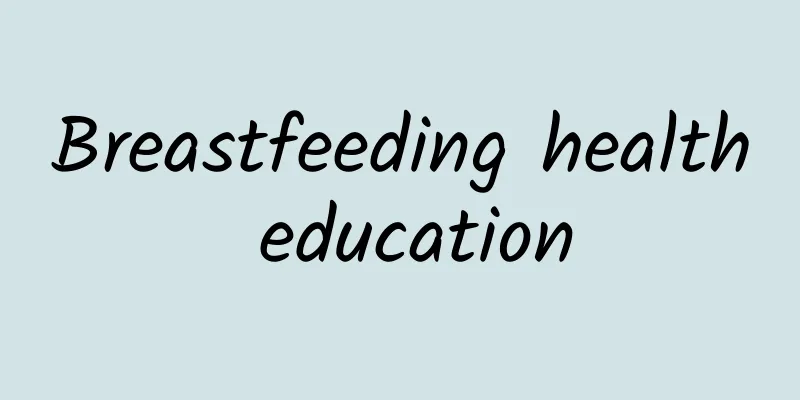Breastfeeding health education

|
Breast milk is an essential and ideal food for infants. It contains a variety of rich nutrients, is most suitable for infants' digestion and absorption, and is beneficial to their growth and development. Breast milk is rich in anti-infection substances and can enhance the baby's disease resistance. Because the amount of breast milk needs to increase accordingly with the baby's growth, exclusive breastfeeding for infants for 4 to 6 months after birth is one of the measures to protect children's survival. Breastfeeding is the most economical, convenient and safest. 1. Benefits of Breastfeeding What are the benefits of breastfeeding? We have found that many young women give up breastfeeding in order to regain their figure as soon as possible after giving birth. In fact, this is counterproductive. The World Health Organization recommends breastfeeding within 1 hour after giving birth, and breastfeeding on demand for 24 hours at the same time for both mother and baby. It is recommended to exclusively breastfeed for 6 months and advocate breastfeeding for more than 2 years. Breastfeeding has many benefits. First, for mothers, breastfeeding can promote the contraction of the uterus, discharge lochia, and restore the uterus as soon as possible. Second, breastfeeding can delay menstruation and ovulation, which will significantly reduce the incidence of ovarian cancer and breast cancer. Third, breastfeeding is the best natural nutritional food for babies, which can fully meet the various needs of infant development. Breast milk contains a large number of immune factors, which can improve the baby's immunity. At the same time, during the sucking process, the baby's face and mouth will develop effectively. Fourth, breastfeeding can promote emotional communication between mothers and infants, increase the baby's sense of security, and play a good role in the baby's future psychological and physiological development. Second, measures to promote successful breastfeeding include 1. Have a written breastfeeding policy that is communicated to all health care staff; 2. Provide all health care personnel with the necessary technical training to enable them to implement this policy; 3. Tell all pregnant women about the benefits and treatment methods of breastfeeding; 4. Help mothers start breastfeeding within half an hour after delivery; 5. Instruct mothers on how to breastfeed and maintain lactation when separated from their babies; 6. Except for breast milk, newborns are prohibited from eating any food or drink unless there is a medical indication; 7. Rooming in mother and baby, allowing mother and baby to be together 24 hours a day; 8. Encourage breastfeeding on demand; 9. Do not give breast-fed babies pacifiers or use pacifiers as comfort objects; 10. Promote the establishment of breastfeeding support organizations and refer mothers discharged from hospital to these organizations. Three tips for successful breastfeeding ⑴ The mother's feeding position: Whether lying, sitting or standing, the mother should be relaxed, comfortable and in a good mood. The baby's body turns towards the mother and is close to the mother's body, facing the mother, with the chin against the breast. ⑵ Baby's sucking posture: The baby's body turns towards the mother and is close to the mother's body, with its mouth wide open, lips protruding, chin pressed against the breast, sucking the nipple and most of the areola. The face bulges when sucking, and the baby sucks and swallows rhythmically. ⑶ How to express milk by hand when the mother and baby are not together: If there is a medical indication to separate the mother and baby for a short period of time, or when the mother goes out to work, milk should be expressed by hand. The correct method is: prepare a clean container, wash your hands, put your thumb on the areola 2 cm away from the base of the nipple, put the other fingers on the opposite side, squeeze into the chest, fix the fingers, do not move on the skin, repeat squeezing-relaxing for a few minutes, stimulate the milk ejection reflex, and squeeze all milk sinuses along the nipple in turn. After collecting the milk, write the time on the outside of the container for easy breastfeeding. At present, it is advocated that the earlier the milk is started, the better. Normal full-term newborns can be breastfed within half an hour after birth, which can prevent neonatal hypoglycemia and promote breast milk secretion. The secretion of milk by breast milk glands is a complex neuroendocrine regulation process. The repeated and vigorous sucking of infants can reflexively keep the concentration of prolactin in the mother's blood at a high level, which generally reaches a peak 30 minutes after breastfeeding, especially at night, which is conducive to promoting milk secretion. When the mother is breastfeeding, the sucking stimulation of the infant causes sensory impulses to be transmitted to the posterior pituitary gland of the brain, which promotes the secretion of prolactin through the blood circulation to the breast, causing the muscle cells around the lactating cells to contract, squeeze the milk into the mammary ducts and the mastoid under the areola, and discharge it from the body. The mother feels that the breasts are full and milk flows out of the nipple. This is the milk ejection reflex. Only when the milk ejection reflex is established can the milk in the breast be squeezed out of the breast for the baby to inhale. Therefore, when the amount of breast milk secretion is small in the first few days, breastfeeding should be insisted on on-demand. It is best to keep the mother and baby in the same room after delivery. The amount of milk will gradually increase, and it is not advisable to add milk or dairy products too early. There is no need to feed regularly in the first two months. You can feed at any time according to the baby's needs. After that, according to the child's sleep pattern, you can feed once every 2-3 hours, gradually extend it to once every 3-4 hours, and gradually stop feeding at night, for a total of 6-7 times a day and night. After 4-5 months, it can be reduced to 5 times. Each breastfeeding lasts about 15-20 minutes. Depending on the sucking ability and living ability, the breastfeeding time can be appropriately extended or shortened, based on fullness. However, the breasts should be sucked empty each time, otherwise a large amount of milk will remain in the breasts, which can cause the inhibitory factor (a polypeptide) in breast milk to inhibit lactating cells and gradually reduce the amount of milk. The above points are my brief introduction to breastfeeding, which can be used as a reference for expectant mothers. (Zhao Qinxia, Lingshou County People's Hospital, Shijiazhuang City, Hebei Province) |
<<: Intravenous infusion therapy and precautions for children
>>: Small test, big effect - learn about urine routine!
Recommend
Can pregnant women eat fried peanuts?
Pregnant women can eat fried peanuts. Although fr...
The Delta variant of the novel coronavirus is fighting back strongly. Prevention needs to learn from the real-world data of vaccines
Is it necessary to get a third booster shot? Who ...
What is the effect of applying cucumber slices on the face?
Cucumbers are widely loved by female friends, esp...
The best time to detect ovulation by B-ultrasound and the characteristics of B-ultrasound images
Some women want a baby. A baby is an indispensabl...
What are the symptoms of female acidic constitution?
In fact, everyone's physique is different. Fo...
Signs of menopause at age 47
Women generally enter menopause between the ages ...
What to do if lochia is not clean after miscarriage
If you find that the lochia is not clear after a ...
What does caesarean section wound fat liquefaction mean? What should I do if caesarean section wound fat liquefaction occurs?
We all know that cesarean section is a common way...
Is 5mm endometrium considered thin?
The thickness of the endometrium actually plays a...
Will I bleed during the first month of pregnancy?
Some female friends actually don’t know much abou...
If you have paronychia, you should treat it as soon as possible. Once it gets worse, it will be troublesome.
Reviewer: Zhang Shuyuan, Chief Physician, Beijing...
What causes swollen legs in women?
Calf edema is caused by excessive blood accumulat...
Do I need to express the milk when I am weaning?
When weaning, many mothers will experience breast...
What does it mean when the pupil is dilated to the edge? Does it mean there is no hope?
We all know that pupil dilation is a common eye s...









